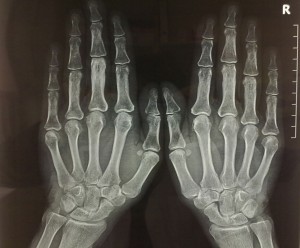
X-radiation, composed of ‘x-rays’, is a form of electro-magnetic radiation. X-rays have had a number of uses. For example, Rosalind Franklin employed a process known as ‘fiber diffraction’—a technique similar to X-Ray crystallography—to discover the structure of DNA. X-Ray devices are used in astronomy; for example, researchers study x-ray emissions from celestial objects. A multiplicity of X-Ray devices is also used in industrial radiography, in microscopic analysis and in airports; in addition, scans of various sorts have been used in art to detect alterations in pigmentation, or to reveal under-drawings and pentimenti.
Medical uses
For clarity, the term ‘medical imaging’ is probably the best one to use here to describe the general use of creating visual representations of the body. These images are analysed in a clinic or a hospital to provide doctors with information about the patient’s body. Medical imaging, of all kinds, looks at internal structures hidden by the skin and bones. The various forms of imaging are also used to treat disease or make an appropriate diagnosis.
If we consider the term ‘medical imaging’ in its widest sense, we should also include biological imaging and radiology. These include X-ray radiography, magnetic resonance imaging (MRI), endoscopy, tactile imaging, elastography, thermography, ultrasound, medical photography and positron emission tomography (PET).
Can hypnosis help me with my scan?
Hypnosis is extremely helpful in reducing stress. If you are having a medical investigation at a hospital or clinic, as a matter of routine or for some other reason, this can cause difficulties for many patients. Some patients feel scared at the thought of having an MRI scan or radiotherapy, while others feel claustrophobic during the process. The responsibility of care should lie with the nurse of doctor operating the equipment. The specialist should be trained to use his tone of voice in order to reduce any unwanted anxiety; he should also employ the right amount of ‘comfort talk—akin to hypnotic language—before, during and after treatment. Nevertheless, some patients still require additional treatment to reduce anxiety, and this is where it is helpful to see a psychotherapist or psychologist. The therapist will teach the patient techniques to reduce anxiety and this may also include some hypnotherapy work.


